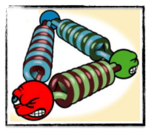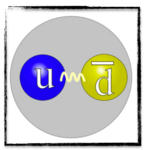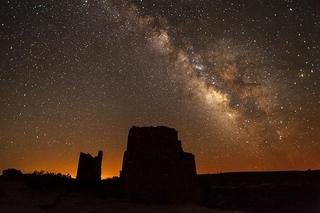The advent of hypothetical pion stars - a new form of compact objects in the universe
Neutron stars are typical astrophysical objects that many have heard about. Like black holes by the way.
Who has not heard anything about those guys, especially in this gastrophysics era where the detection of gravitational waves is all over the place.

[image credits: Wikipedia]
One of the interesting outcome of the recent observations of gravitational waves is that lots of activities have been triggered around compact stellar objects.
This morning, browsing the new research papers of the day, I have read a very interesting article about pion stars.
This triggered my attention as I have never thought about pion stars before. As it can be guessed from the wording, pion stars are potential stars made of pions. Surprize, surprize…
Stars made of bosons (pions are bosonic particles) have been studied for more than 50 years (see here for a review, not too accessible to anyone without any background in physics). Although this works nicely theoretically-speaking, not a single observation has allowed today to conclude to their existence.
So why bothering about pion stars? I will let you know, but before, let me re-explain what is a pion.
WHAT IS A PION?
Before going further, let us discuss pions. In the world of the elementary particles, the tiniest bits of matter are some guys called quarks (see this post for more information).
Quarks are strongly interacting particles. This means, that they are interacting with each other by virtue of strong interactions, the strongest of all fundamental forces of nature that is also known as quantum chromodynamics (see here).

[image credits: Nobel Prize]
And thanks to the properties of the strong interactions, quarks can form composite systems, i.e. particles made of several quarks.
This is sketched on the figure on the right where three quarks are glued together thanks to strong interactions. The most well-known of these systems are incontrovertibly the protons and the neutrons, but many other options are possible.
In particular, it exist a class of particles named mesons that are made of one quark and one antiquark.

[image credits: Wikipedia]
We have discovered a whole bunch of mesons during the last hundred years, and those we know the best are the pions, i.e. the guys in which we are interested in this post (see the picture on the left for an example).
Pions are particles made of up and down quarks and antiquarks and can thus be either neutral (up-antiup or down-antidown) or charged (up-antidown or down-antiup).
I admit that life is in reality much more complicated than this, but let’s stick to this for the sake of simplicity.
FROM PIONS TO PION STARS
A few 0.0001 seconds after the Big Bang, in Standard Cosmology (see here for more information), the Universe is comprised mainly of a gas of pions mixed with electrons, muons and neutrinos. The universe is indeed old enough so that all quarks have started to form composite objects.

[image credits: pixabay]
We can therefore imagine that some of those pions could condensate and form a pion star. The conditions for this mechanism to occur could indeed be realized.
The only drawback is that pions are unstable. How could then the star survive? This is where the research paper mentioned earlier comes into the game.
The authors have shown that pion stars were objects for which standard (and computer-intensive) lattice simulations of quantum chromodynamics were achievable. In other words, the properties of the pion stars can be evaluated from first principles thanks to simulations on super-computers.
They did the calculations and demonstrated that there were options in which the weak and electromagnetic decays of the pion condensates were not allowed, although usually, pions are known to be unstable and to decay either via weak or via electromagnetic interactions.
In other words, the authors have shown that it was possible that the pion condensate was stable, or that pion stars could exist!
Just to give some details, pion stars are actually stabilized by the presence of the surrounding electrons and muons. The stars will then still decay, but potentially after billions of years so that stars of masses reaching 250 times the solar mass could still be present in our universe today.
What is left to do? Well, pion stars have not been observed so far so that they are still classified among the ensemble of hypothetical astrophysical objects. This nonetheless does not contradicts the fact that they could exist.
SUMMARY
In this post, I introduced a new class of astrophysical objects that I have never about before: pion stars. I explained how they were formed and why this was thought impossible until know. What has changed? Supercomputers that allowed to run simulations and show that there were theory configurations in which those stars could exist!
SteemSTEM
SteemSTEM is a community-driven project that now runs on Steemit for more than a year. We seek to build a community of science lovers on Steemit and to promote well written/informative Science Technology Engineering and Mathematics (STEM) postings in order to make Steemit a place for fascinating STEM content.
More information can be found on the @steemstem blog and on our discord server and in our last project report.
Fun idea. I never heard of Pion stars before :-)
A star could be defined as massive body that counterbalances the effect of the gravitational force by a source of energy (in standard stars, nuclear fusion). That equilibrium between gravity and radiative pressure guarantees the star's stability.
In pion stars, what would be the source of energy?
Without one, a gravitational induced pion-condensate, would immediately collapse into a black hole, especially if its mass is as huge as 250 solar masses. Beyond the black hole horizon, I can then this object evolving happily as a an hypothetical quark star, or maybe even a strange star (plasma of u, d and s quarks).
This is a complicated question to answer and the answer is in the paper. If I have well understood, the entire system relies on chiral perturbation theory and the bounding of the system is connected to the isospin symmetry. The isospin density is connected to the charge density that counterbalanced the gravitational pressure.
Bosonic stars are actually good candidate to mimic black holes. Their radius is however much larger.
I had a quick look at the paper. I am not too sure I got an answer to my question, because I honestly understood less than half of it.
I believe what they call the pionic pressure would be what counterbalances gravity. Then, I have to extrapolate to what I know. Without entering the details, would it be that the compression by gravity of the pions force-stacks each of them into a state resulting in a counter pressure, analogously to the state degeneracy of electrons or neutrons that stabilizes white dwarfs and neutron stars respectively?
In the end, there is no need for a source of energy. Quantum physics rules do the job.
In terms of gut feelings (i.e. with no logic), I am quite doubtful of the past or present existence of these pion-electron stars, and that even if I love exotic things ;-)
In short, the weak isospin interactions of the pions balance the gravitational collapse. It is sufficient and you don't need to invoke anything new. (On top of that, they have verified that the pion condensate is stable, as pion are unstable particles.)
In the second paragraph, "gastrophysics?"
Rest of the text is amazing
I didn't define it on purpose... You can google it, but please add gravitational wave in the research box (otherwise, enjoy your meal :p )
Now I found your old article, from the time before I joined to SteemIt :)
^^
Pions make u gassy!
This is the detail I didn't want to know :D
always down for some #science/#astronomy/#physics
#cosmos #howtheunverseworks
#spacenerd #sciencechannel #4Life
#steemstem
@lemouth :0 thank for this
You can add #steemstem to this list, in fact :)
Done:)
Lol! Thank you. This is appreciated :)
Yeh I love hearing new steemMashups :)
okay so 2 things
"We seek to build a community of science lovers on Steemit and to promote well written/informative Science Technology Engineering and Mathematics (STEM) postings in order to make Steemit a place for fascinating STEM content."
"A few 0.0001 seconds after the Big Bang, in Standard Cosmology"
the unit of time measurement used in the first seconds of the big bang are called Plank time and there actually Crazy small in fact they say there was more plank moments in the first second then seconds in all of time since!
Crazy right?
any way Im go check out
the @steemstem blog and join the team so dont be a stranger ok
after all us astronerds gotta stick together
am I right? or am I right?
smooches
<3 kel
The big bang model consists in standard cosmology :)
Please join us on the chat. We will welcome you there (at least the others as I am not very visible those days ;) )
awesome
Love to :)
I'm confused by the relationship between up and antidown (and vice versa). Is it that they have the same spin, but one is an antiparticle?
Also, what differentiates a quark from an antiquark?
Up and antiup are the particle and antiparticule version of the same guy. Similarly for down and antidown. A particle and an antiparticle are the same, except with the electric charge (and all other quantum numbers in general) being opposite. This applies to quarks and antiquarks, as well as to electrons and positrons for instance.
Does it clarify?
Some, I think. My brain wants to understand it as if a particle is made up of the same stuff as an antiparticle, but with opposite charge, but that seems a little too simple. Is that closer to correct, or am I even farther off?
The elementary particles are not made of anything, as they are elementary. For those, what I said above applies.
For composite states, it is sufficient to replace any constituent by an anti-guy. For instance, a particle by the associated antiparticle and an antiparticle by the associated particle. I think this agrees with your brain :)
So just to clarify:
The hypothesis is that there is a theoretical phase transition to a somewhat stable Pion condensate within the Quark-Gluon-Plasma regime, right?
Would you also expect a pion star to form out of a further collapsing neutron star or do you require Big Bang conditions for such an abundance of antimatter (antiquarks)?
To my understanding, we are not dealing with the QGP here.
Again from my understanding, they can be potentially formed from pion gases, and are hence disconnected from neutron stars completely. The best moment for their formation is right after the big bang when the universe is full of pions. There is no relation here to the matter-antimatter asymmetry.
This cosmos, the same for all that exists, was created by no god and no man, but always it was, is and will be forever a living fire, measures burning and measures extinct. I liked your post, good luck to you and have a good day.
Thanks a lot for passing by.
Scientifically speaking, we are not sure of this. There are many options for the future, and there is a kind-of initial moment for the starting point of the universe. Hopefully, we will learn more from data soon or later.
WOW never heard about that. I love to stargaze and read all about our Cosmos, but this info I missed... Thanks for sharing and keep it up!
Me too., which is why I wrote about it. Those objects are however hypothetical (no observation, at least so far).
Yeah, many things started as a hypothesis, let's see with this one what's gonna happen! Anyway, really nice post, I must follow you! :D
We will see or not see. In both cases we learn. Thanks for having passed by! ^^
Are neutron stars the same as pulsars?
I once read an article about the possibility of having a life form in pulsars.
Pulsars are a special class of neutron stars that spin and that regularly emit jets of particles that can be observed. Those emissions consist of light that can be observed. More information can be found for instance here.
Thanks for the information sir. Let me read up the link you provided
you are welcome!
is it possible that hydrogen allow them to expand and turning the star into a giant?
I am not sure to understand the question, but I guess 'no' should be a correct answer :)
Okay, these are all new terminologies.
Pions, mesons, quarks...
I'll have to look them up some more
Thanks for the educative post.
You are welcome. I know this new stuff, for anyone not in our field, may be complicated. For this reason, I have given links were more information can be found. I hope this helps. Otherwise, feel free to shoot any question.
PS: pions and mesons are defined in my post. Only quarks require some external clicks :p